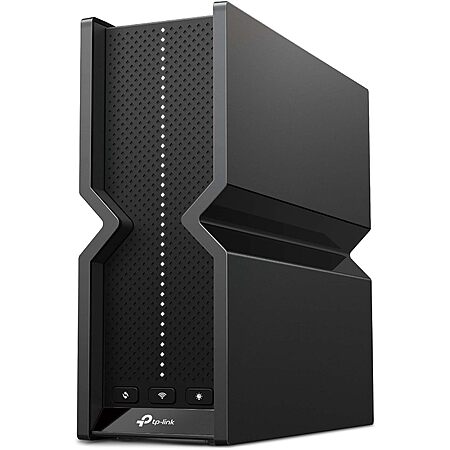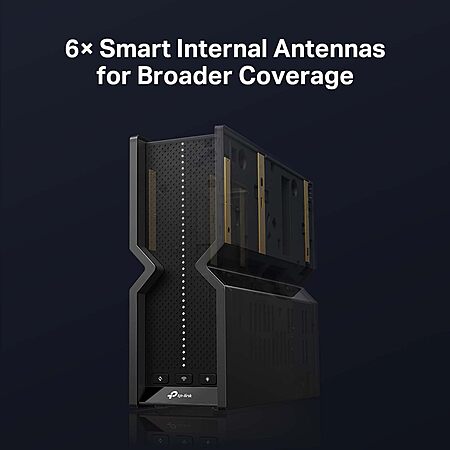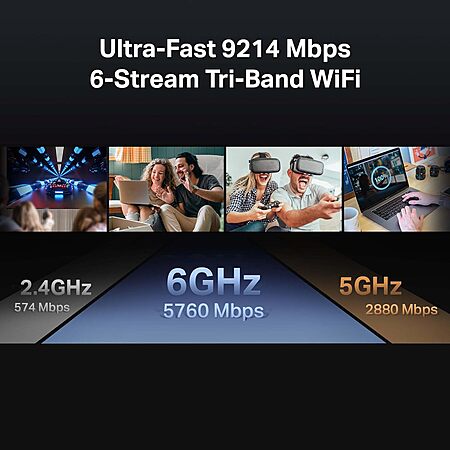expiredphoinix | Staff posted Apr 30, 2024 07:15 AM
Item 1 of 4
Item 1 of 4
expiredphoinix | Staff posted Apr 30, 2024 07:15 AM
$250: TP-Link BE9300 Tri-Band Wi-Fi 7 Router (Archer BE550)
$250
$300
16% offAmazon
Visit AmazonGood Deal
Bad Deal
Save
Share










Leave a Comment
4 Comments
Sign up for a Slickdeals account to remove this ad.
MOST client devices today are 'stuck' at 2×2 MIMO: As can be seen from the tables (right), most client devices today are STILL only 2×2 MIMO [§7]. Why haven't devices switched to 4×4? Because (1) there is (currently) no compelling need for that speed today (there is no app that 'requires' 400 Mbps to function) and more importantly (2) the increased speed is not worth the tradeoff in greatly reduced run time for battery powered devices.
Supporting 4×4 MIMO takes more power, and for battery powered devices, runtime is FAR more important.
You will see the spec sheets for many modern phones that MIMO is 4×4, but look closely and notice that this is only for cellular, not Wi-Fi.
However, of note is that many (non-Apple) Wi-Fi 6/6E devices support 160-MHz channels (HE160), which instantly doubles throughput vs Wi-Fi 5 using 80-MHz channels (VHT80). So speed is increasing dramatically via wider channels, not increased MIMO levels.
https://www.wiisfi.com/
Wi-Fi is messy -- it can be hard to understand, is full of gotchas, caveats, contradictions, tradeoffs, a ton of hype, and is constantly changing and improving. And yet, and spite of all of that, Wi-Fi can work remarkably well, provided that you follow just a couple of very simple rules:
You want
'full bars'
use a Wi-Fi 6 or later router
use Wi-Fi 6 or later client devices
be as close to the router/AP as possible -- you want 'full bars'
have the fewest obstacles walls, floors, etc possible between client+router
You 'should' get near 1 Gbps of Wi-Fi throughput when right next to the router. But you may not. It all depends. If you pay attention to the details, you can dramatically improve your chances of successfully obtaining 1 Gbps throughput...
Obtaining 1 Gbps Wi-Fi throughput: In general, keep the following points in mind, and you can achieve 1 Gbps throughput over Wi-Fi to the 'typical' 2×2 MIMO client device:
Use modern devices -- older devices may not have the 'horsepower' to sustain high throughput
In Wi-Fi 5, the only way to obtain 1 Gbps throughput is via 160 Mhz channels, which most client devices do not support and if supported, you need to be very close to the router.
In Wi-Fi 6, you CAN obtain 1 Gbps throughput via an 80 MHz channel in 5 GHz, but you need great signal strength topmost 1201 PHY speed, by being very close to the router.
But you WANT to use 160 MHz channels instead of 80 MHz channels in 5 GHz because requires DFS channel support that will extend the range at which you can successfully obtain 1 Gbps throughput. But Apple devices do not support HE160 in 5 GHz.
But using 160 MHz channels in 5 GHz (there are only two) could either (1) work just fine, or (2) be impossible -- due to potential DFS channel conflicts.
Due to this DFS channel uncertainty, using Wi-Fi 6E (6 GHz band) is much better (can always use 160 MHz channels), but only if you are close to your router, and both client+router must fully supports Wi-Fi 6E. Also, Wi-Fi 6E routers (with all the features you really want) can be very expensive AND range of 6 GHz channels is reduced as compared to 5 GHz channels.
And in all cases above, you WANT a 4×4 MIMO router (instead of 2×2 MIMO), as that helps to to extend the range at which you can successfully obtain 1 Gbps throughput.
NEED (not just want) 1 Gbps Wi-Fi throughput? If you NEED (and not just want) 1 Gbps Wi-Fi throughput, then you need a Wi-Fi 6E/7 router+client so that you can 100% guarantee that a 160 MHz 6 GHz band channel can always be used. The challenge today is (1) finding a Wi-Fi 6E router, with 'recommended' 4×4 specs, at a great price there is a 2×2 MIMO honorable mention in the chapter above and (2) do you have client devices that support Wi-Fi 6E?
With Wi-Fi 6E and a 160 MHz 6 GHz channel, you should be able to easily get 1 Gbps throughput in the same room as the router/AP, and 'likely' get 1 Gbps throughput even one room away through a single wall and if not, then something close to 1 Gbps speeds one room away. Also, remember also that 6 GHz band channels have less range than 5 GHz channels!
TP-Link BE550 (Wi-Fi 7)
And then of course, with increasing distance and obstacles, Wi-Fi speeds will decrease quickly. Add Wi-Fi 6E access points [§18], wired/Ethernet back to the main router, where needed to again guarantee 1 Gbps speeds.
Wi-Fi 6: You can use a Wi-Fi 6 router and 160 MHz 5 GHz channels to obtain 1 Gbps speeds, but since DFS channels are then used, there is a risk that the router will 'kick you off' the DFS channel, resulting in the router reverting to an non-DFS 80 MHz channel. For Wi-Fi 6 80 MHz channels, you CAN still get 1 Gbps throughput, but only when very close to the router/AP, and most likely not through any obstacles (expect only 700+ Mbps one room away).
Stick your toes into Wi-Fi 7 waters?: The TP-Link BE550 (amazon.com), seen right, is a Wi-Fi 7 router, and stands out from all its competitors due to the value price of $300. Virtually all other Wi-Fi 7 routers start out at around double that. The BE550 is only 2×2 MIMO, has Wi-Fi 6E built-in, and comes with Wi-Fi 7 MLO (5 GHz+6Ghz) for future Wi-Fi 7 clients.
WANT great throughput (often 1 Gbps; sometimes less) + best value: If you want the best value and fastest Wi-Fi speeds that comes with, then it is hard to argue against a mid-range recommended [§21] Wi-Fi 6 4×4 MIMO router. I expect that most readers of this paper will fall into this category. A single well placed Wi-Fi 6 router in a home using 80 Mhz channels can deliver 1 Gbps speeds right next to the router, 700+ Mbps speeds in the next room, maybe 300+ Mbps two rooms away, and so on. For what most people use the Internet for, these Wi-Fi speeds are very respectable. And as a bonus, if you are fortunate enough that 160 MHz channels in 5 GHz can be used (potential DFS channel issues), then nearly double these speeds is possible (only for 160 MHz capable client devices).
And adding a Wi-Fi 6 access point [§18] wired/Ethernet back to the main router, can guarantee 1 Gbps Wi-Fi throughput somewhere else in the house.
4×4 MIMO: You want a router with 4×4 MIMO because that gives a small dB boost to both transmitted and received Wi-Fi signals. Often times, that means a slightly better MCS level can be used for 'at range' devices, which then directly means slightly better throughput. If you can live without that small boost in range/speeds, then there is nothing wrong with a modern 2×2 MIMO router, especially if cost is a factor for you, and especially if most Wi-Fi use will be 'near' to the router.
Why I keep pushing 4×4 MIMO: My personal experience over many years of testing is that 4×4 MIMO routers 'at range' regularly outperform 2×2 MIMO routers. For example, I have a test setup going 40 feet through three walls, a closet full of stuff, and a major obstacle (HVAC air handler), where Wi-Fi throughput in 5 GHz (160 MHz channel) can either be 300 Mbps (a 2×2 MIMO AP), or 600 Mbps (a 4×4 MIMO AP).
Leave a Comment